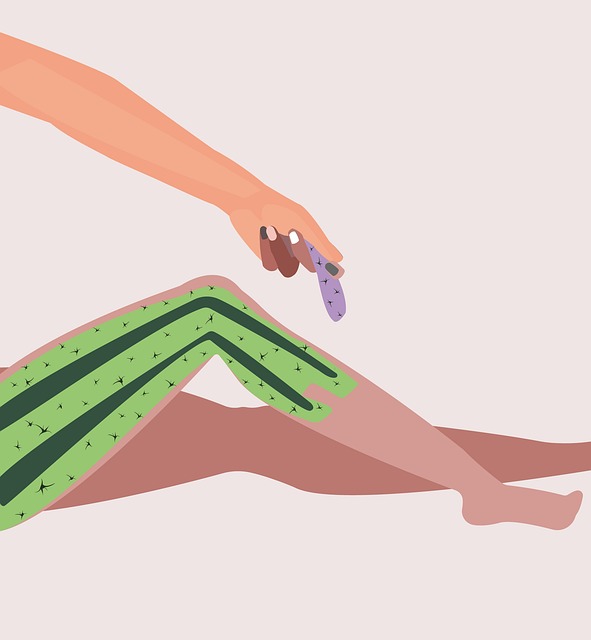Head-to-toe waxing disrupts the natural hair growth cycle by targeting hairs during their active (anagen) phase, smoothing skin temporarily. Not all hairs are removed simultaneously due to variations in the anagen cycle, leading to uneven regrowth. After waxing, hair follicles enter a resting (telogen) phase followed by natural regrowth, often resulting in thicker, coarser hairs. To maintain smooth skin and support healthy regrowth, incorporate post-waxing strategies like moisturizing, exfoliation, nutrition, and exercise.
The practice of full body waxing, or head-to-toe waxing, has gained popularity for its temporary smooth skin sensation. However, understanding the science behind hair regrowth is essential for those considering this procedure. This article delves into the intricate details of the hair growth cycle and its interaction with depilation methods. We explore the immediate effects of extensive waxing on hair follicles and delve into long-term regrowth patterns. Additionally, practical strategies to promote healthy post-waxing hair growth are offered.
Understanding Hair Growth Cycle and Its Impact on Full Body Waxing
The human hair growth cycle is a fascinating process that involves three distinct phases: anagen, catagen, and telogen. During anagen, which is the active growth phase, hair follicles divide rapidly, resulting in new hair growth. This phase typically lasts for several years. Catagen is a brief transition period where the follicle stops producing hair and prepares for shedding. Telogen is the resting phase, during which old hairs naturally fall out to make way for new ones. Understanding this cycle is crucial when considering head-to-toe waxing because it influences the effectiveness of hair removal methods and the subsequent regrowth.
Full body waxing, or anagen depilation, involves removing hair from the root during its active growth phase. This method can be highly effective in achieving smooth skin for a prolonged period since wax disrupts the hair’s connection to the follicle, halting growth temporarily. However, it’s essential to remember that not all hairs are removed simultaneously due to individual variations in the anagen cycle. Some follicles might still be in the growing phase while others have entered the resting phase, leading to uneven regrowth. This is why maintaining a consistent waxing routine and allowing enough time for the hair growth cycle to restart becomes vital for optimal results after head-to-toe waxing.
The Short-Term Effects of Head-to-Toe Waxing on Hair Follicles
Full-body waxing, often referred to as head-to-toe waxing, is a popular method for hair removal that involves removing hair from all parts of the body simultaneously. While it provides smooth skin for an extended period, understanding its impact on hair follicles is crucial. In the short term, head-to-toe waxing can cause temporary damage to hair follicles due to the process’s aggressive nature. This damage manifests as hair shedding or telogen effluvium, where a significant amount of hair falls out a few weeks post-waxing. However, this effect is usually temporary, and hair follicles have a remarkable ability to regenerate.
The follicle’s natural cycle includes phases of growth (anagen), transition (catagen), and rest (telogen). Waxing disrupts the anagen phase, pushing many hairs into the catagen stage prematurely. This stimulation triggers the body to prepare for potential hair loss, leading to increased shedding. Yet, after this initial period, the follicles enter their telogen phase, a resting state, before naturally regenerating and entering a new growth phase.
Long-Term Hair Regrowth Patterns After Comprehensive Waxing
After a comprehensive head-to-toe waxing session, understanding the long-term hair regrowth patterns is crucial for managing expectations and maintaining skin health. The initial phase post-waxing typically involves a significant reduction in hair visibility due to the removal of all hair follicles from the surface. This period can last anywhere from several weeks to a few months, depending on various factors such as individual hair growth rates and skin sensitivity.
During this time, it’s important to remember that the hair isn’t permanently removed; instead, it’s in a dormant phase before naturally regrowing. Many people observe thicker and coarser hairs emerging after the initial shedding period, which is a sign of the body’s response to stimulate new growth. This process varies across different parts of the body, with areas like the legs and arms often showing more rapid regrowth compared to facial hair or other sensitive regions.
Strategies to Optimize and Support Healthy Hair Regrowth Post-Waxing
After a full-body waxing session, promoting healthy hair regrowth is essential to maintaining a smooth and confident skin. One effective strategy is to nourish the skin with moisturizing products containing ingredients like shea butter or coconut oil, which help restore the skin’s natural barrier and prevent dryness. Exfoliating gently before and after waxing can also aid in removing dead skin cells, allowing for better hair removal and stimulating blood circulation, which supports new growth.
In addition to skincare routines, dietary changes play a significant role. Adequate protein intake is crucial for hair health as it provides the building blocks for collagen production, essential for strong and healthy hairs. Incorporating foods rich in vitamins A, C, and E, along with minerals like zinc and iron, can further support optimal regrowth after head-to-toe waxing. Regular exercise is another beneficial habit, promoting better blood circulation throughout the body, including the scalp, fostering a conducive environment for hair follicles to thrive.
Full body waxing, or head-to-toe waxing, significantly impacts the hair growth cycle. While it can lead to temporary hair loss, understanding the long-term regrowth patterns allows for effective post-waxing care. By employing strategies that optimize and support healthy hair growth, individuals can ensure their skin stays smooth with minimal disruption to their natural hair cycle. These practices are essential for maintaining a radiant and comfortable state after comprehensive waxing treatments.
